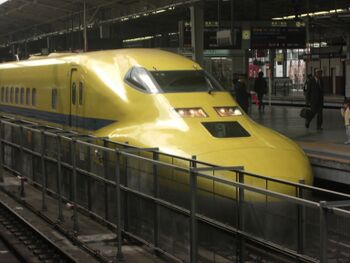Bullet train (Japan)/Catalogs/Dr. Yellow
| The metadata subpage is missing. You can start it via filling in this form or by following the instructions that come up after clicking on the [show] link to the right. | |||
|---|---|---|---|
|

The bullet train (新幹線 shinkansen) network in Japan has, as of March 2010, never suffered a fatal accident since its inauguration in 1964. This is partly due to Japan Railways's extensive safety procedures which include the use of test trains officially known as Shinkansen Denki Kidoo Sookoo Shikensha (新幹線電気軌道総合試験車, 'comprehensive shinkansen test train') but each nicknamed Dr. Yellow (ドクターイエロー Dokutaa Ieroo).
Test trains do not carry passengers but instead house equipment to analyse the overhead wires, rails and other aspects of the journey, often while travelling at the bullet train's official top speed of 180mph (300km/h). This machinery is hidden behind the blacked-out windows of seven carriages, which each hold different equipment, according to information released to the media in 2010:
- Carriages 1, 6 and 7: Signals and power monitoring.
- Carriage 2: Equipment to check the condition of overhead power cables.
- Carriage 3: Data collection equipment and carriage 5's dome controls.
- Carriage 4: Rail inspection via a platform under the floor.
- Carriage 5: Dome allowing inspection of pantographs.[2]
Information collected by the test trains is analysed in order to direct maintenance engineers to any adjustments or repairs that are required.
'Dr. Yellow' trains run between Tokyo and Fukuoka[3] to a unpublished timetable, though train spotters try to work out where the trains are likely to next appear. An urban legend passed down among enthusiasts holds that the sighting of a 'Dr. Yellow' brings the spotter good fortune.[4]
Footnotes
- ↑ An amateur website in Japanese identifies this as 'T4', a modified 700-series bullet train.
- ↑
- Pantograph [r]: A device for connecting electrically powered vehicles to overhead power cables. [e]
- ↑ Fukuoka's railway station is named 'Hakata'.
- ↑ Japan Times: ''Dr. Yellow' train keeps line safe, elates spotters.' 11th March 2010.
